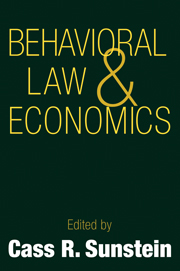Book contents
- Frontmatter
- Contents
- Contributors
- Acknowledgments
- Introduction
- Part I Overview and Prospects
- Part II Heuristics and Biases: Shortcuts, Errors, and Legal Decisions
- Part III Valuation: Values and Dollars in the Legal System
- 8 Experimental Tests of the Endowment Effect and the Coase Theorem
- 9 Assessing Punitive Damages (With Notes on Cognition and Valuation in Law)
- 10 Framing the Jury: Cognitive Perspective on Pain and Suffering Awards
- 11 Behavioral Economic Analysis of Redistributive Legal Rules
- 12 Do Parties to Nuisance Cases Bargain After Judgment? A Glimpse Inside the Cathedral
- Part IV The Demand for Law: Why Law Is As It Is
- Index
12 - Do Parties to Nuisance Cases Bargain After Judgment? A Glimpse Inside the Cathedral
Published online by Cambridge University Press: 05 June 2012
- Frontmatter
- Contents
- Contributors
- Acknowledgments
- Introduction
- Part I Overview and Prospects
- Part II Heuristics and Biases: Shortcuts, Errors, and Legal Decisions
- Part III Valuation: Values and Dollars in the Legal System
- 8 Experimental Tests of the Endowment Effect and the Coase Theorem
- 9 Assessing Punitive Damages (With Notes on Cognition and Valuation in Law)
- 10 Framing the Jury: Cognitive Perspective on Pain and Suffering Awards
- 11 Behavioral Economic Analysis of Redistributive Legal Rules
- 12 Do Parties to Nuisance Cases Bargain After Judgment? A Glimpse Inside the Cathedral
- Part IV The Demand for Law: Why Law Is As It Is
- Index
Summary
The Question
Nuisance cases have figured prominently in the literature of law and economics because they present simple and sometimes charming fact patterns in which courts must pick between awarding property rights to parties and awarding them money. A nuisance suit arises when a plaintiff complains to a court that his neighbor is interfering unreasonably with the use and enjoyment of his property – usually because the neighbor is engaging in some activity that is noisy, noisome, or otherwise offensive to the plaintiff. A typical example of a nuisance case that has figured prominently in law and economics scholarship is the old English case of Bryant v. Lefever. The plaintiff and the defendants were neighbors. The defendants began rebuilding their house and built a high wall with timber stacked on top of it; the wall ran alongside the plaintiff's chimney and caused some of the smoke from it to back up into the plaintiff's house. The plaintiff sued, claiming the wall was a nuisance. The court rejected the claim. Coase used this case to illustrate his analysis in The Problem of Social Cost:
The smoke nuisance was caused both by the man who built the wall and by the man who lit the fires.… On the marginal principle it is clear that both were responsible and both should be forced to include the loss of amenity due to the smoke as a cost in deciding whether to continue the activity which gives rise to the smoke. […]
- Type
- Chapter
- Information
- Behavioral Law and Economics , pp. 302 - 322Publisher: Cambridge University PressPrint publication year: 2000
- 9
- Cited by



